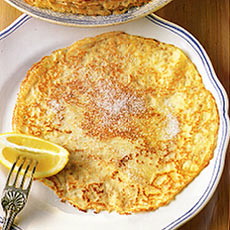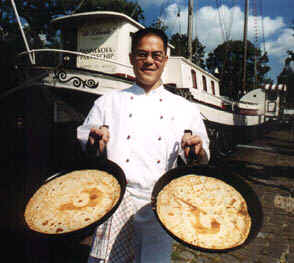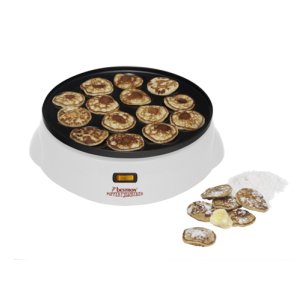
Those of us who take notice of such things will know that today is Mardi Gras or Fat Tuesday, known as Shrove Tuesday or Pancake Day in Britain.
Pancake Day or ‘Shrove Tuesday’ (the Tuesday which falls 41 days before Easter) is the eve of the Lenten fast. On this day in earlier times all Christians made their compulsory confessions or ‘shrifts’ from which the name ‘Shrove Tuesday’ derives, and took their last opportunity to eat up all the rich foods prohibited during Lent. Thus all eggs, butter and fat remaining in the house were made into pancakes, hence the festival’s usual nickname of Pancake Day.
So make haste! Today’s your last chance to make merry before being shriven on Ash Wednesday prior to the long 40 day trial of Lent.
Well, it is if you believe in certain invisible sky-beings, anyhow.
When I was a child it was the the signal for an endless round of church services, with Monday and Wednesday morning and evening services added to the usual choir practices, weddings, early eucharists, matins and evensongs. All that tedium plus giving up something you like as a reminder of Christs’s suffering in the wilderness too. What a way to screw up a child. But I can’t complain: I did it for the singing and it’s given a me an appreciation of music, art and the mellifluosity of 17th century language that has enriched my life even though inspired by sky-fairy worship. Of course I’m now just another atheist, which is the real achivement of the Church of England, to have produced generations of moderate atheists with an appreciation for the arts.
But I digress.
The best things about the whole Lent thing really is that it’s a harbinger of spring and good food: today pancakes, on Good Friday hot cross buns, at Easter roast lamb with all the new spring vegetable trimmings. These little seasonal cultural celebrations give shape to a dismal time of year, when all is gray and endlessly tedious. So today, despite my atheism I’ll be gorging on pancakes with lemon and sugar. For morale, you know.
English pancakes are of the classic crepe variety and very easy to make:

Whisk a medium size egg into about a a quarter-litre of milk in a medium sized bowl, and whisk in plain (ie with no raising agent in it) flour by dessertspoonfuls, plus a small pinch of salt and a teaspoon of vegetable or sunflower oil, until the mixture’s free of lumps and is the consistency of single cream. Cover it with a plate or clingfilm and set it in the fridge for at least an hour before needed. (Whisking in the oil helps the pancakes not stick, and setting aside in a cold place gives time for the starch in the flour to swell, making for a lighter and less raw-flour tasting pancake.)
When ready to eat, quarter a couple of nice juicy lemons and some caster sugar, take the mix from the fridge and if it looks too thick whisk in a little more milk or water. Fire up a good heavy frying pan, preferably cast-iron and well-seasoned but nonstick if you’re nervous, on a moderate to high heat. It’s hot enough when a drop of water sizzles right away to nothing. Swirl round enough vegetable or sunflower oil to cover the base of the pan and put it back on the heat: when you see a slight blue haze, use a ladle to pour on just enough batter to cover the bottom of the pan. Give it a good swirl till it’s even and there are no thick spots and cook till the top side becomes opaque and bubbles can be seen.
Then comes the fiddly bit: you can either flip it with a fishslice or wide-bladed turner or if you’re like me and a complete showoff, you can with a clever flick of the wrist flip it in midair. Cowards will slide it onto a plate and then invert the plate into the pan but this takes time and makes for a tough pancake, in my opinion.
The trick to frying pancakes is having everything ready beforehand so that you can keep up a smooth sequence of frying, flipping and serving while maintaining the pan on the correct heat without it catching fire. It goes – heat, pour, cook, flip, cook, plate, sugar, lemon, fold, serve, repeat. The aim is to have the pancake so hot the lemon fumes go up your nose. Oh and did I say that if you have an extractor fan, it’s a very good time to use it? The lack of extractor fans historically in British homes might well explain why pancakes at home are confined to once a year.

Dutch pannekoeken are slightly different, more like the gigantic Breton crepes you can buy in Northern France, made with a mixture of buckwheat and wheat flour, very thin, very wide and mostly served with savoury fillings like cheese and ham or ragouts of various kinds. Whatever the filling it’s adorned with sweet, sticky stroop. There’s also a tiny version, made in a special pan, known as the poffertje, which is generally served sweet with powdered sugar.

You can buy pancakes ready made at supermarkets here and in the UK (Sainsbury’s does the Dutch ‘Oma’s Pannekeoeken’ brand, if I remember rightly, and M&S sells crepes suzettes), but they’re not a patch on homemade. If you’re making British crepe style pancakes, I urge you to try flipping the pancakes in midair: you might have a couple of initial errors and get some mix on the ceiling but hey, it’s cheap entertainment and once you get the knack you’ll be wanting to make pancakes all the time just to show off your new party trick.